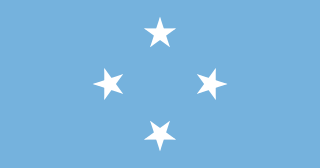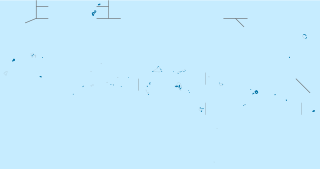
The Federated States of Micronesia or simply Micronesia, is an island country in Oceania associated with the United States. It consists of four states – from west to east, Yap, Chuuk, Pohnpei and Kosrae – that are spread across the western Pacific. Together, the states comprise around 607 islands that cover a longitudinal distance of almost 2,700 km (1,678 mi) just north of the equator. They lie northeast of Indonesia and Papua New Guinea, south of Guam and the Marianas, west of Nauru and the Marshall Islands, east of Palau and the Philippines, about 2,900 km (1,802 mi) north of eastern Australia, 3,400 km southeast of Japan, and some 4,000 km (2,485 mi) southwest of the main islands of the Hawaiian Islands.

Chuuk Lagoon, previously Truk Atoll, is an atoll in the central Pacific. About 1,800 kilometres north-east of New Guinea, it is located mid-ocean at 7 degrees North latitude and is part of Chuuk State within the Federated States of Micronesia (FSM). A protective reef, 225 kilometres (140 mi) around, encloses a natural harbour 79 by 50 kilometres, with an area of 2,130 square kilometres. It has a land area of 93.07 square kilometres, with a population of 36,158 people and a maximal height of 443 m (1,453 ft). Weno city on Moen Island functions as the atoll's capital and also as the state capital and is the largest city in the FSM with its 13,700 people.

Chuuk State is one of the four states of the Federated States of Micronesia (FSM). The other states are Kosrae State, Pohnpei State, and Yap State. It consists of several island groups:

This is a list of the buildings, sites, districts, and objects listed on the National Register of Historic Places in the Federated States of Micronesia. There are currently 26 listed sites located in all 4 states of the Federated States of Micronesia.

Tonowas , also known by its Spanish name of Dublon, is an island in the Chuuk lagoon, Federated States of Micronesia. It has an area of 8.8 km² and the population was 3,200 at the time of the last census (1980). A narrow single-lane track rings the island, allowing land access to the small villages Five schools and Japanese military ruins, which include the remains of a seaplane anchorage and large fuel storage tanks. A Japanese administrative centre dating from the 1920-1930s mandate period can still be found, and is currently used as a government building.

Xavier High School is a private Catholic coeducational high school run by the USA East Province of the Society of Jesus on the island of Weno in Chuuk, Federated States of Micronesia. It was established by the Jesuits in 1952. It was the first high school in the Trust Territory of the Pacific Islands. Bishop Thomas Feeney, S.J., D.D. from the New York Province of the Society of Jesus originally envisioned a minor seminary to train local clergy. Soon after, Xavier Seminary became the first college preparatory school in the Western Pacific.
Japanese Lighthouse may refer to:

The Wiichen Men's Meetinghouse is a historic building site in Peniesene on Moen Island in Chuuk State of the Federated States of Micronesia. The site, deemed archaeologically significant due to its place in Chuukese folklore, includes a pre-contact period petroglyph panel and swimming basin. Local history claims that this was the meeting place of six brothers who became the first chieftains of Chuuk.

The Japanese Lighthouse is an abandoned lighthouse situated atop Navy Hill in Garapan, Saipan, in the Northern Mariana Islands. It was listed on the National Register of Historic Places in 1974. The lighthouse is one of the few surviving pre-World War II, civilian structures built by the Japanese.
The Japanese Lighthouse, or Poluwat Lighthouse, is an abandoned lighthouse situated on Alet Island in Poluwat, Chuuk in the Federated States of Micronesia. It was completed in 1940 by the Japanese and was in use until being attacked by U.S. forces in World War II. It was listed on the National Register of Historic Places in 1983. The lighthouse is a good example of pre-World War II "marine architecture" built by the Japanese.

The Chief Agriculturist House is a historic house in Kolonia, the capital of Pohnpei State in the Federated States of Micronesia. It is a steel and concrete structure, built in the mid-1920s when Pohnpei and the other Caroline Islands were part of the Japanese South Seas Mandate. It was one of the highest-quality buildings constructed on Pohnpei during the Japanese administration, and was the home of the Japanese weatherman and agricultural overseer, said to be the second most powerful figure in Japanese Micronesia.

The World War II Japanese Army Headquarters for the defense of Tonowas, an island in what is now Chuuk State in the Federated States of Micronesia, was located in an underground bunker in the village of Roro. The underground facilities, including an office, communications center, print shop, supply room, and health clinic, were built in response to American air raids against the facilities, which were associated with the major naval facility of the Imperial Japanese Navy in Chuuk Lagoon.

Tonnachau Mountain, is a mountain on Moen Island in Chuuk State of the Federated States of Micronesia. Rising to a height of 1,100 feet (340 m), it is not the highest peak of Moen, which is Mount Teroken to the south. Tonnachau is, however, a prominent landmark rising above Chuuk International Airport. The mountain also has an important place in Chuukese culture and prehistory, with archaeologically significant prehistoric middens and fortifications on its summit ridge which date back as far as 4,000 BCE. Chuukese tradition states that its hero Soukachou built a fort on Tonachau when he arrived from Kosrae and established rule over the lagoon. The mountain also has extensive remains of mainly Japanese fortifications erected during World War II.

The Japanese Hydro-electric Power Plant is a former hydroelectric power generation plant and historic site in Kolonia, the capital of Pohnpei State in the Federated States of Micronesia. The site is historically and culturally important as a representative of three different eras in the island's history. The site is important in the culture of Pohnpei as a location of high-quality stones gathered for use in ritual ceremonies involving the pounding of kava and drinking preparations from the plant. In the early 1900s, when Pohnpei was administered as part of German New Guinea, the German administration established an experimental forest, planting a diversity of trees from around the world, some of which continue to thrive in the area. Finally, in the 1920s, during the Japanese South Seas Mandate, a hydroelectric facility was built here. When the property was listed on the United States National Register of Historic Places in 1976 the concrete power plant building and water catchment basin survived.

Likinlulem is a major archaeological site on the island of Kosrae in the Federated States of Micronesia. The site encompasses more than 7 acres (2.8 ha) on either side of Likinlulem Stream on the island's southwestern coast, in an area that is now overgrown mangrove swamp. It includes at least nine large enclosures with extensive internal features, a channelized stream, canoe landing, and a large open platform that is subject to inundation at high tide. Occupancy of the site has been dated to 1200-1800 CE, with one area possibly dating as far back as 1000 CE. The site is an important element of the island's oral history as it was here that its paramount chiefs are said to have held court prior to the ascendancy of Leluh c. 1400. When the site was listed on the United States National Register of Historic Places in 2004, it had been surveyed but not extensively excavated.
The Fauba Archaeological Site is a prehistoric stoneworks on a mountain ridge on Tol Island in Chuuk State of the Federated States of Micronesia. The site consists of an area enclosed by a stone wall that is roughly triangular in shape. The wall is between 1 and 1.5 meters in height, and is about 1 meter thick. The enclosed area includes a number of stone platforms, and there is a refuse midden outside the enclosure that is believed to be associated with the site. The exact purpose of the site is a subject of debate: although its siting has obvious military benefits (including commanding views of Chuuk Lagoon and other islands of the atoll, it is not clear that it actually saw military activity.

The Japanese Artillery Road and Pohndolap Area are a historic area on Sokehs Island in the Federated States of Micronesia. Sokehs has a prominent north-south ridge (known locally as "Pohndolap", overlooking the state capital Kolonia, and was fortified by the Japanese during World War II. They built a road to the summit area and emplaced anti-aircraft guns on the ridge. The ridge was also a key site in the 1910 Sokehs Rebellion against Japanese rule, and the remnants of a Pohnpeian fort are also in the area. The surviving elements of these fortifications were listed on the United States National Register of Historic Places in 1976. The old road is now part of a hiking trail, leading up to the fortifications.

The Spanish Wall is the deteriorating remnant of Spanish Fort Alphonso XIII in Kolonia, the capital of Pohnpei State in the Federated States of Micronesia. When built, the wall was about 0.5 miles (0.80 km) in length and 8 feet (2.4 m) in height with a parapet that ranged in height from 2–3 feet (0.61–0.91 m). The wall was built by Spanish administrators of Pohnpei in 1887 after a local uprising drove the local Spanish authorities onto a ship in the harbor. Most of the wall was taken down by the German administration that took over in the early 20th century, after the Spanish–American War. The remains of the wall, about 700 feet (210 m) and two arches, are now part of a local park.

The Japanese Elementary School for Ponapean Children is a historic school building in Kolonia, the capital of Pohnpei State in the Federated States of Micronesia. The surviving building is one of two reinforced concrete buildings, constructed c. 1920-21 by the Japanese authorities of the South Seas Mandate, which included the island of Pohnpei, then known as "Ponape". These buildings were the sole educational facility on the island for native children, those of Japanese dependents attending a separate, segregated facility. They were heavily damaged by bombing during World War II, with one of them being demolished and the other restored for use as part of the island's hospital.









